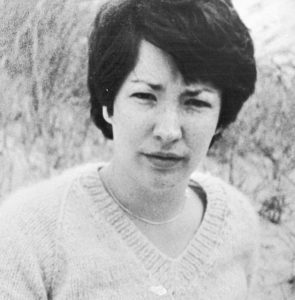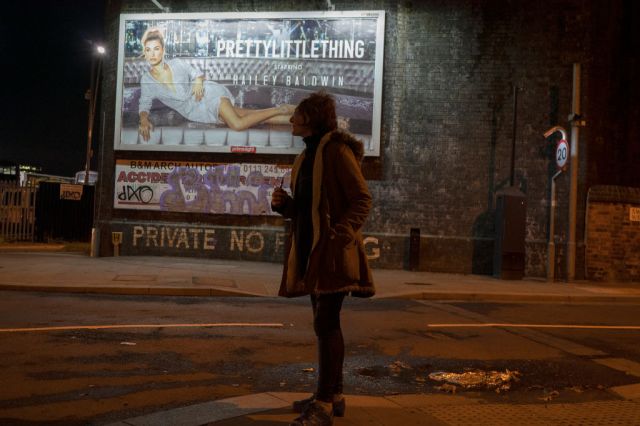Holbeck, Leeds: the only ‘managed’ zone for prostitution in the UK. Credit: Christopher Furlong/Getty Images

It was 40 years ago today that Jacqueline Hill took a bus home to her hall of residence in Leeds. She was 20 and in the third year of an English degree. She was returning home from the city centre, and it was only a short walk from the bus stop to where she lived on Alma Road, Headingley. She would have been wary. For more than five years, a serial killer had been terrorising women in the North of England, slashing and mutilating his victims. Five of his 12 fatal attacks had been in Leeds, along with several brutal assaults. The police seemed clueless, and women were anxious.
It wasn’t that late when Jacqueline got off the bus. At 9.23pm on 17 November, she crossed a busy main road, not realising she had been spotted by Peter Sutcliffe, a 34-year-old lorry driver. Sutcliffe later told the police that he had just finished eating a portion of fried chicken in his Rover when he saw her. “I decided she was a likely victim,” he said.
She was only 100 yards from safety when he drove past, parked his car and hit her on the head with a hammer. He dragged her into a lane that led to some rough ground, struck her again but paused when he heard someone walking past. Then he returned to the attack, using a screwdriver to slash and stab her several times. Jacqueline had just become the final victim of the man known as the Yorkshire Ripper.
A week ago, a women’s group, Leeds Spinners, placed a plaque close to where Jacqueline died. It bears an inscription that tries to fill in the character of a young woman most of us only know, if at all, as a victim of one of this country’s worst serial killers. The gesture gained extra poignancy when Sutcliffe’s death at the age of 74 was announced on Friday. He outlived his last victim by almost exactly four decades.

Rage at the incompetence of West Yorkshire police lives on, though. Sutcliffe was careless, leaving so much evidence that he was interviewed by detectives on nine occasions — but never once put on an identity parade or arrested in connection with the murders by the Ripper squad.
After Sutcliffe’s death, West Yorkshire’s current Chief Constable, John Robins, made a belated apology for mistakes in the inquiry. But even then he couldn’t resist a whinge. He complained that the hard work of bringing the Ripper to justice had been overshadowed by the language used by the upper ranks, who had described women as pawns and seemed to belittle the death of prostitutes.
Robins’s apology was all very well, but his force didn’t bring Sutcliffe to justice. The arrest was made in Sheffield in January 1981 by a traffic patrol from South Yorkshire, who were suspicious about the stolen number plates crudely taped to his car. And it’s not as though the language used by senior officers in the 1970s was incidental to the conduct of the investigation. On the contrary, it reflected a deep-seated misogyny that led to indefensible judgements about the victims and persuaded senior officers to doubt — and in some instances ignore — crucial evidence. To put it bluntly, some of the early victims, while definitely not involved in prostitution, didn’t meet West Yorkshire police’s exacting standards for female conduct. One woman had a black boyfriend! Another went to the pub without her husband!
From early on in the case, detectives and the press wrongly assumed that the killer’s motive was a hatred of prostituted women. It didn’t bear a moment’s scrutiny: the first four attacks, all in the second half of 1975, had nothing to do with women who were selling sex. It did, however, appeal to the detective in charge of the inquiry, Assistant Chief Constable George Oldfield, who was convinced he was hot on the heels of a latter-day Jack the Ripper. He overlooked the fact that Sutcliffe’s first three victims, who all survived, were attacked in quiet residential streets and a country lane nowhere near Leeds’s red light district. One was a 14-year-old schoolgirl, Tracey Browne, who provided a photofit of her attacker that turned out to closely resemble Sutcliffe. But detectives decided she was too young and had been in the wrong place to belong in the series, thus ruling out a vital piece of evidence.
Another early victim, 46-year-old Olive Smelt from Halifax, also offered crucial testimony. She encountered Sutcliffe twice on the night of the assault in August 1975 — first in a pub, where he made an obscene remark, and later when he spotted her on his way home. Sutcliffe stopped his car and spoke to her again before striking her twice on the head with a hammer. He was slashing her buttocks when a passing car scared him off. Mrs Smelt described her attacker as around 30, with dark hair and a beard. She was also certain that he had a local accent. Sutcliffe was 29 at the time and matched her description closely.
Unfortunately, detectives were sceptical about Mrs Smelt’s value as a witness. In a secret report summarising the murders, she was dismissed in astonishingly pejorative language: “She is of loose morals,” the report declared, adding that “it was her usual custom … to visit public houses in Halifax on her own”. What detectives really believed about Mrs Smelt was revealed in a slip by then Chief Constable, Ronald Gregory, who described her in a newspaper article as “a prostitute”. It fitted the “prostitute killer” narrative and damaged Mrs Smelt’s credibility in the eyes of the inquiry, even though it had nothing to do with reality.
Sutcliffe’s fourth victim, and the first to be killed, was 28-year-old Wilma McCann, a mother of four. She was not involved in prostitution either. But Sutcliffe was tired of having his attempts to kill women interrupted and he targeted her in Chapeltown, a red-light area in Leeds where kerb crawlers didn’t attract attention. His fifth victim, 42-year-old Emily Jackson, whom he attacked in January 1976, was selling sex in Chapeltown as a result of a family financial crisis. Sutcliffe had realised prostituted women were easier targets, desperate for money and willing to get into his car. Mrs Jackson was the second woman to die, and her injuries were horrific.
By the following year, evidence that should have led to Sutcliffe was mounting up. In October 1977 he made his biggest mistake, leaving a brand-new £5 note in the bag of one of his two Manchester victims. In a rare piece of effective detective work, officers traced it to a consignment of notes that had gone to a small number of firms in West Yorkshire, one of which employed Sutcliffe. He was convinced the game was up, but the line of inquiry petered out. Even so, Sutcliffe was a local man with a Yorkshire accent, his appearance matched photofits produced by another surviving victim, Marilyn Moore, and his car had been spotted in red light districts hundreds of times.
Yet when a junior detective, DC Andy Laptew, interviewed him as part of the £5 note inquiry and suggested that Sutcliffe deserved further investigation, Oldfield banged the table with his fist. “Peter Sutcliffe is not the Yorkshire Ripper,” he shouted, threatening anyone who disagreed with a return to traffic duties. There was a reason for Oldfield’s bizarre behaviour, though not a good one. Increasingly desperate about his failure to catch the killer, Oldfield was easy prey for an amateurish hoaxer who sent him anonymous letters and a tape. The man had a distinctive Wearside accent, something none of the survivors had described — but hey, what did they know? I questioned the tape’s authenticity when I first heard it but it flattered Oldfield, addressing him personally and reinforcing his ideas about the killer’s motives.
In the summer of 1979, he decided to ignore the surviving victims, with their regrettable personal habits, and release the tape to the public. West Yorkshire police wasted £1m on a publicity campaign, asking people to look out for a killer with a North-East accent. In Halifax, Olive Smelt was outraged; she told me so when I interviewed her after Jacqueline’s murder in 1980. But a floundering investigation had taken a catastrophic turn and three more women — Jacqueline, Barbara Leach and Marguerite Walls — would die as a result.
West Yorkshire police’s apology has come too late for Mrs Smelt, who died in 2011. But I’m troubled by Robins’s claims about modern policing, not least the idea that misogynist attitudes have been “consigned to history”. It is true that police forces have better technology than they did in the 1970s, but I see no end to victim-blaming. The “short skirt” defence in rape cases has been replaced by a “digital strip search”, where victims are asked to hand over medical records, school reports and mobile phones, allowing detectives to access intimate photos and messages.
The result is evident in crime statistics: around 55,000 women report a rape to the police in England and Wales each year, but there were only 1,439 convictions in 2019-20. Victims are still being discredited and having their stories disbelieved; it’s more sophisticated than West Yorkshire police’s division of Sutcliffe’s victims into “innocent girls” and the rest, but the underlying impulse is pretty much the same. The situation is so dire that the Victims’ Commissioner, Dame Vera Baird, has argued that rape is being decriminalised.
In Leeds itself, women challenge Robins’s assertion that policing is now “wholly victim-focused”, ensuring that “those harmed by crime are at the heart of what we do”. His force operates the controversial “managed approach” to prostitution, allowing men to kerb crawl in Holbeck, a light industrial area to the south of the city centre, without fear of arrest — as long as they stick to certain hours. It didn’t prevent the murder of a young Polish woman, Daria Pionko, who was kicked to death in Holbeck by a sex buyer in 2015.
The commercial sex trade always attracts predators, putting women who sell sex at risk, while local women say they are pestered for sex while out shopping or on their way to work. Last week a local headmaster, Ben Mallinson told the BBC he was afraid one of his female pupils would be abducted by men looking for sex, as several had already been propositioned. Holbeck is only four or five miles from Headingley, where Jacqueline Hill was murdered by a man who hated women, yet it now seems to be operating as a “managed misogyny” zone.
It has been painfully clear for a long time that Hill’s death and those of other women could have been avoided if West Yorkshire police had put aside their prejudices and listened to Sutcliffe’s surviving victims. On this tragic anniversary, it is hard not to think of everything Jacqueline might have done in those four lost decades: the friends she would have made, the career she might have have followed, and the children she could have had.
It is also hard to contemplate the fact that women in Leeds and other parts of the country still don’t feel safe from predators, let down by a criminal justice system that seems incapable of locking up violent men. Misogyny is as entrenched as ever — and I’m as angry now as I was when Jacqueline was murdered all those years ago.










Join the discussion
Join like minded readers that support our journalism by becoming a paid subscriber
To join the discussion in the comments, become a paid subscriber.
Join like minded readers that support our journalism, read unlimited articles and enjoy other subscriber-only benefits.
Subscribe